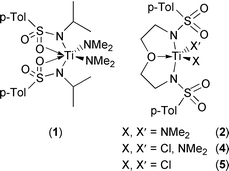“Bidentate” and “tridentate” sulfonamideligands for titanium complexes: crystal structures and solution dynamics elucidating an η2 or η3-coordination mode†
Abstract
Highly air- and moisture-sensitive complexes having

* Corresponding authors
a Graduate School of Engineering Science, Kyushu University, Kasuga, Fukuoka 816-8580, Japan
b Institute of Advanced Material Study, Kyushu University, Kasuga, Fukuoka 816-8580, Japan
c Yokkaichi Research Center, TOSOH Corporation, Yokkaichi, Mie 510-8540, Japan
Highly air- and moisture-sensitive complexes having

 Please wait while we load your content...
Something went wrong. Try again?
Please wait while we load your content...
Something went wrong. Try again?
S. Hamura, T. Oda, Y. Shimizu, K. Matsubara and H. Nagashima, J. Chem. Soc., Dalton Trans., 2002, 1521 DOI: 10.1039/B110481K
To request permission to reproduce material from this article, please go to the Copyright Clearance Center request page.
If you are an author contributing to an RSC publication, you do not need to request permission provided correct acknowledgement is given.
If you are the author of this article, you do not need to request permission to reproduce figures and diagrams provided correct acknowledgement is given. If you want to reproduce the whole article in a third-party publication (excluding your thesis/dissertation for which permission is not required) please go to the Copyright Clearance Center request page.
Read more about how to correctly acknowledge RSC content.
 Fetching data from CrossRef.
Fetching data from CrossRef.
This may take some time to load.
Loading related content
